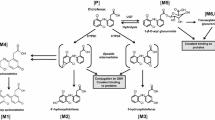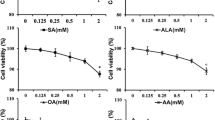Abstract
Chronic ciprofibrate administration resulted in distinct differences in hepatic responses between the two species examined. In the rat, hepatomegaly was observed with the coordinate induction of carnitine acetyltransferase, peroxisomal β-oxidation and cytochrome P450IVA1 activities. The latter induction of cytochrome P450IVA1-dependent fatty acid hydroxylase activity was specific to this cytochrome P450 sub family, as ciprofibrate pretreatment resulted in an inhibition of the enzyme activities associated with the cytochrome P450 IIB and IA sub-families. Induction of mitochondrial enzymes were also noted in the rat, but at a substantially lower level than the microsomal and peroxisomal enzyme changes noted above. The majority of these enzyme changes were reversible in the rat after a 4-week, inducer-free period. In contrast, the marmoset displayed a different pattern of enzyme changes in response to ciprofibrate and at the high dose level, inhibition of microsomal fatty acid hydroxylase activity was observed in addition to no change in carnitine acetyltransferase activitiy. Although peroxisomal β-oxidation activity was induced in the marmoset, the specific activity was 10-fold lower than in the rat, concomitant with only minimum changes in the liver: body weight ratio. Taken collectively, our data have demonstrated that the marmoset is relatively refractory to ciprofibrate-induced liver enzyme changes with the implication that the extrapolation of the associated hepatotoxicity clearly documented in rodents must be viewed with extreme caution in non-human primates.
Similar content being viewed by others
References
Allen KL, Green CE, Tyson CA (1987) Comparative studies of peroxisomal enzyme induction in hepatocytes from rat, cynomolgus monkey and human by hypolipidaemic drugs. Toxicologist 7: 63 (abstract)
Awasthi YC, Beutler E, Srivastava SK (1975) Purification and properties of human erythrocyte glutathione peroxidase. J Biol Chem 250: 5144–5149
Beaufay H, Bendall DS, Baudhuin P, Wattiaux R, De Duve C (1959) Tissue fractionation studies. Analysis of mitochondrial fractions from rat liver by density-gradient centrifugation. Biochem J 73: 628–637
Beckett RB, Weiss R, Stitzel RE, Cenedella RJ (1972) Studies on the hepatomegaly caused by the hypolipidaemic drugs nafenopin and clofibrate. Toxicol Appl Pharmacol 23: 42–53
Bieber LL, Abraham T, Helmrath T (1972) A rapid spectrophotometric assay for carnitine palmitoyltransferase. Anal Biochem 50: 509–518
Blumcke S, Schwartzkopff W, Lobeck H, Edmondson NA, Prentice DE, Blane GF (1983) Influence of fenofibrate on cellular and subcellular liver structure in hyperlipidaemic patients. Atherosclerosis 46: 105–116
Bock PP, Kramar R, Pavelka M (1980) Peroxisomes and related particles. Cell Biology Monographs 7: 44–74. Springer-Verlag, Berlin
Bronfman M, Inestrosa NC, Leighton F (1979) Fatty acid oxidation by human liver peroxisomes. Biochem Biophys Res Commun 88: 1030–1036
Burke MD, Prough RA, Mayer RT (1977) Characteristics of a microsomal cytochrome P-448 mediated reaction. Ethoxyresorufin-O-deethylation. Drug Metab Dispos 5: 1–8
Challiner MR, Park BK, Odum J, Orton TC, Parker GL (1980) The effects of phenobarbitone on urinary 6β-hydroxycortisol excretion and hepatic enzyme activity in the marmoset monkey (Callithru jacchus). Biochem Pharmacol 29: 3319–3324
Chirgwin JM, Przybyla AE, MacDonald RJ, Rutter WJ (1979) Isolation of biologically active ribonucleic acid from sources enriched in ribonuclease. Biochem J 18: 5294–5299
Christen P, Peacock WC, Christen AE, Wacker WEC (1970) Urate oxidase in primate phylogenesis. Eur J Biochem 12: 3–5
Cohen AJ, Grasso P (1981) Review of the hepatic response to hypolipidaemic drugs in rodents and assessment of its toxicological significance to man. Food Cosmet Toxicol 19: 585–605
Davison C, Benziger D, Fritz A, Edelson J (1975) Absorption and disposition of 2-(4-(2,2-dichlorocyclopropyl)phenoxy)-2-methylpropanoic acid, WIN 35, 833 in rats, monkeys and man. Drug Metab Dispos 3: 520–524
Eacho PI, Foxworthy PS, Johnson WD, Hoover DM, White SL (1986) Hepatic peroxisomal changes induced by a tetrazole-substituted alkoxyacetophenone in rats and comparison with other species. Toxicol Appl Pharmacol 83: 430–437
Earnshaw D, Dale JW, Goldfarb PS, Gibson GG (1988) Differential splicing in the 3′ non-coding region of rat cytochrome P-452 (P450IVA1) mRNA. Febs Lett 236: 357–361
Edelson J, Benziger DP, Arnold A, Beyler AL (1979) Blood levels, tissue distribution and the duration of action in rats of ciprofibrate, a new hypolipidaemic agent. Atherosclerosis 33: 351–357
Elcombe CR (1985) Species differences in carcinogenicity and peroxisome proliferation due to trichloroethylene. A biochemical human hazard assessment. Arch Toxicol 8 [Suppl]: 6–17
Elcombe CR, Mitchell AM (1986) Peroxisome proliferation due to di-(2-ethylhexyl)phthalate (DEHP): species differences and possible mechanisms. Environ Health Pers 70: 211–219
Elcombe CR, Styles JA (1989) Species differences in peroxisome proliferation. Toxicologist 9: Abstract no. 249
Emudianughe TS, Caldwell J, Sinclair KA, Smith RL (1983) Species differences in the metabolic conjugation of clofibric acid and clofibrate in laboratory animals and man. Drug Metab Dispos 11: 97–102
Gariot P, Pointel JP, Barrat E, Drouin D, Debry G (1984) Etude morophometrique des peroxysomes hepatiques chez des malades hyperlipoproteinemiques traites par fenofibrate. Biomed Pharmacother 38: 101–106
Goldenberg H, Huttinger M, Kampfer P, Kramar R, Pavelka M (1976) Effect of clofibrate application on morphology and enzyme content of liver peroxisomes. Histochemistry 46: 189–196
Hanefeld M, Kemmer C, Kadner E (1983) Relationship between morphological changes and lipid lowering action ofp-chlorophenoxy-isobutyric acid (CPIB) on hepatic mitochondria and peroxisomes in man. Atherosclerosis 46: 239–246
Hawkins JM, Jones WE, Bonner FW, Gibson GG (1987) The effect of peroxisome proliferators on microsomal, peroxisomal and mitochondrial enzyme activities in the liver and kidney. Drug Metab Rev 18: 441–515
Kluwe WM, Haseman JK, Fielding D, Douglas J, Huff JE (1982) The carcinogenicity of dietary di-(2-ethylhexyl)phthalate (DEHP) in Fischer 344 rats and B6C3F1 mice. J Toxicol Environ Health 10: 797–815
Krajl M (1965) A rapid microfluorimetric determination of monoamine oxidase. Biochem Pharmacol 14: 1683–1685
Lake BG, Evans JG, Gray TJB, Korosi SA, North CJ (1989) Comparative studies on nafenopin-induced hepatic peroxisome proliferation in the rat, Syrian hamster, guinea pig and marmoset. Toxicol Appl Pharmacol 99: 148–160
Lalwani ND, Reddy MK, Qureshi SA, Reddy JK (1981) Development of hepatocellular carcinomas and increased peroxisomal fatty acid β-oxidation in rats fed 4-chloro-6-(2,3-xylidino)-2-pyrimidinylthio acetic acid (Wy-14, 643) in the semipurified diet. Carcinogenesis 2: 645–650
Lalwani ND, Reddy MK, Qureshi SA, Sirtori CR, Abiko Y, Reddy JK (1983) Evaluation of selected hypolipidaemic agents for the induction of peroxisomal enzymes and peroxisome proliferation in the rat liver. Hum Toxicol 2: 27–48
Lazarow PB (1982) Compartmentation of β-oxidation of fatty acids in peroxisomes. In: Sies H. (ed) Metabolic compartmentation. Academic Press, New York, pp 317–329
Lazarow PB, Shio H, Leroy-Houyet MA (1982) Specificity in the action of hypolipidaemic drugs: increase of peroxisomal β-oxidation largely dissociated from hepatomegaly and peroxisome proliferation in the rat. J Lipid Res 23: 317–326
Lee YP, Lardy HA (1965) Influence of thyroid hormones onl-α-glycerophosphate dehydrogenases and other dehydrogenases in various organs of the rat. J Biol Chem 240: 1427–1436
Lee YP, Takemori AE, Lardy H (1959) Enhanced oxidation of α-glycerophosphate by mitochondria of thyroid hormone fed rats. J Biol Chem 234: 3051–3054
Lowry OH, Rosebrough NJ, Farr AL, Randall RJ (1951) Protein measurement with the Folin phenol reagent. J Biol Chem 193: 265–275
Mann AH, Price SC, Mitchell FE, Grasso P, Hinton RH, Bridges JW (1985) Comparison of the short-term effects of di-(2-ethyl-hexyl)phthalate, di-(n-hexyl)phthalate and di-(noctyl)phthalate in rats. Toxicol Appl Pharmacol 77: 116–132
Nash T (1953) The colorimetric estimation of formaldehyde by means of the Hantzsch reaction. Biochem J 55: 416–421
Omura T, Sato R (1964) The carbon monoxide-binding pigment of liver microsomes. 1. Evidence for its haemoprotein nature. J Biol Chem 239: 2370–2378
Orton TC, Parker GL (1982) The effect of hypolipidemic agents on the hepatic microsomal drug-metabolising enzyme system of the rat. Induction of cytochrome(s) P-450 with specificity towards terminal hydroxylation of lauric acid. Drug Metab Dispos 10: 110–115
Orton TC, Adam HK, Bentley M, Holloway B, Tucker MJ (1984) Clobuzarit: species differences in the morphological and biochemical response of the liver following chronic administration. Toxicol Appl Pharmacol 73: 138–151
Parker GL, Orton TC (1980) Induction of oxyisobutyrates of hepatic and kidney microsomal cytochrome P-450 with specificity towards hydroxylation of fatty acids. In: Gustafsson JA, Carlstedt-Duke J, Mode A, Rafter J (eds). Biochemistry biophysics and regulation of cytochrome P-450. Elsevier, Amsterdam, pp 373–377
Prospero TD (1974) A simplified assay for succinate dehydrogenase. Method Developments in Biochemistry 4: 411–412
Reddy JK, Lalwani ND (1983) Carcinogenesis by hepatic peroxisome proliferators: evaluation of the risk of hypolipidaemic drugs and industrial plasticisers to humans. CRC Crit Rev Toxicol 12: 1–58
Reddy JK, Bunyaratvej S, Svoboda D (1969) Microbodies in experimentally altered cells. IV. Acatalasemic (CSb) mice treated with clofibrate. J Cell Biol 42: 587–596
Reddy JK, Azarnoff DL, Hignite CE (1980) Hypolipidaemic hepatic peroxisome proliferators form a novel class of chemical carcinogens. Nature 283: 397–398
Reddy, JK, Lalwani ND, Qureshi SA, Reddy MK, Moehle CM (1984) Induction of hepatic peroxisome proliferation in non-rodent species including primates. Am J Pathol 114: 171–183
Sharma R, Lake BG, Foster J, Gibson GG (1988a) Microsomal cytochrome P-452 induction and peroxisomal proliferation by hypolipidaemic agents in rat liver: a mechanistic inter-relationship. Biochem Pharmacol 37: 1193–1201
Sharma R, Lake BG, Gibson GG (1988b) Co-induction of microsomal cytochrome P-452 and the peroxisomal fatty acid β-oxidation pathway in the rat by clofibrate and di-(2-ethylhexyl)phthalate: dose-response studies. Biochem Pharmacol 37: 1203–1206
Svoboda DJ, Azarnoff DL (1966) Response of hepatic microbodies to a hypolipidaemic agent, ethylchlorophenoxyisobutyrate (CPIB). J Cell Biol 30: 442–450
White BA, Bancroft FC (1982) Cytoplasmic dot hybridisation. Simple analysis of relative mRNA levels in multiple small cell or tissue samples. J Biol Chem 257: 8569–8572
Author information
Authors and Affiliations
Rights and permissions
About this article
Cite this article
Makowska, J.M., Bonner, F.W. & Gibson, G.G. Comparative induction of cytochrome P450IVA1 and peroxisome proliferation by ciprofibrate in the rat and marmoset. Arch Toxicol 65, 106–113 (1991). https://doi.org/10.1007/BF02034935
Received:
Revised:
Accepted:
Issue Date:
DOI: https://doi.org/10.1007/BF02034935




